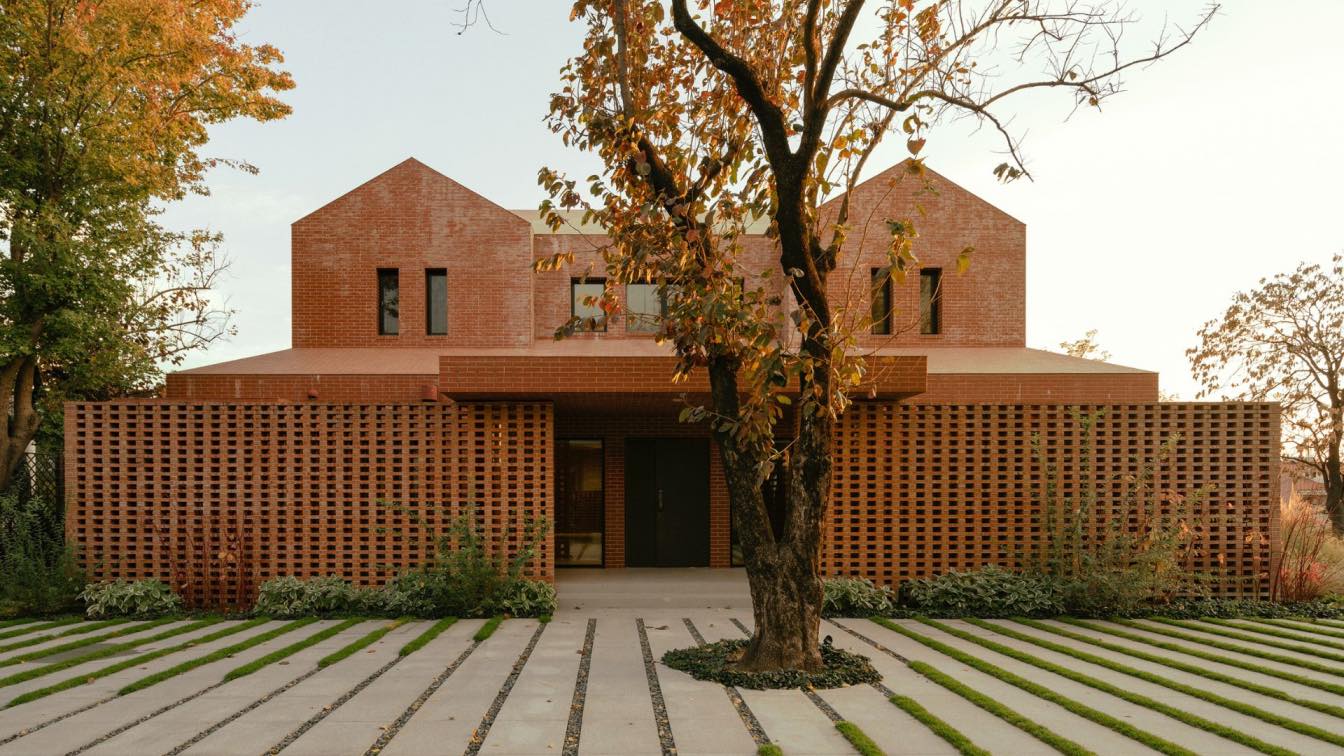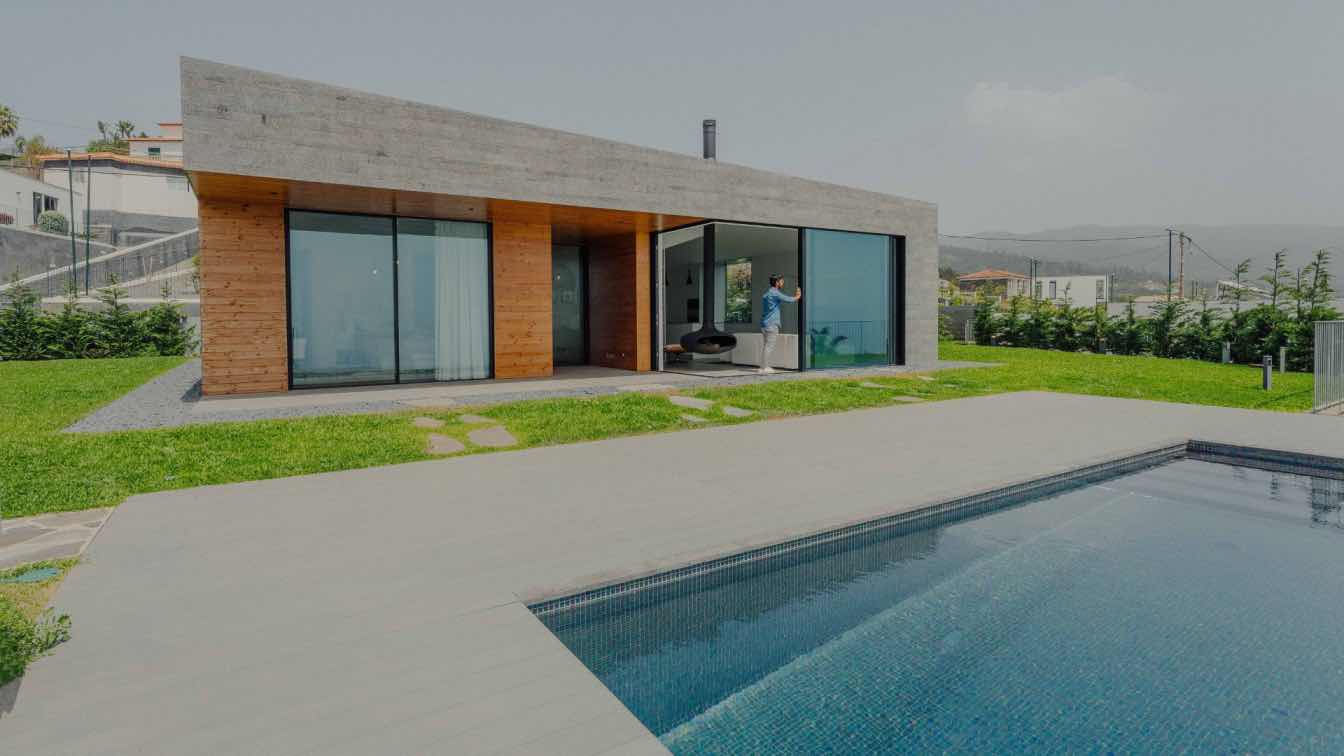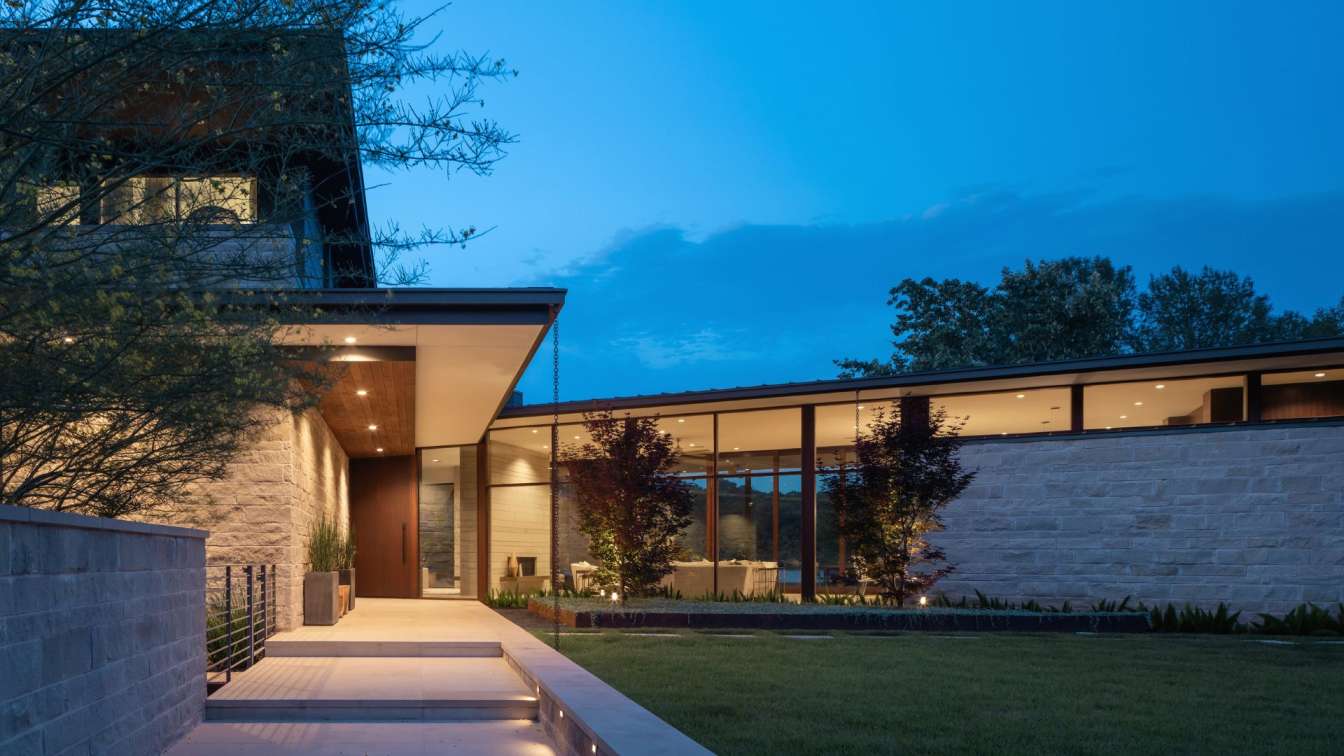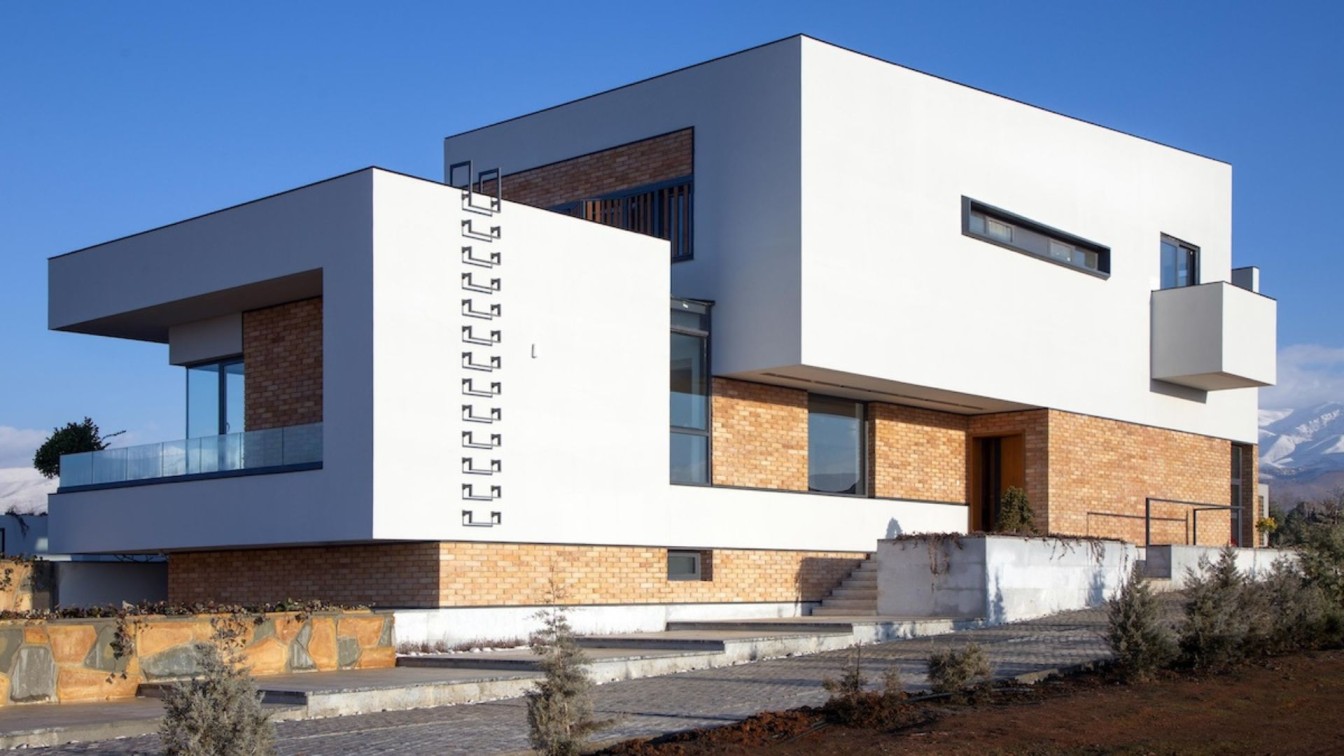Changping District is 30km to the north of Beijing, the scenery of which is completely different from that of an international city. KiKi ARCHi has completed a renovation project within 15 months there. Carrying the happy time of its owner’s childhood in the country, it seeks not the concrete object of memory, but the memory itself.
The bushy mountain and mirror-like lake provide a natural barrier to noise, which attracts the owners a lot. The original 1,300㎡ site contains a large courtyard and a 200 ㎡ European-style house. This sense of contradiction inspired the team to rethink. After site analysis and discussion, KiKi ARCHi decided to first re-establish the relationship between the house and the landform, which includes multiple dimensions such as the relationship between ‘terrain and building’, ‘architectural appearance and the surrounding environment’, ‘function and the living experience’. Thus, the 8m height difference of the site was fully utilized, and the garden at the lower level was linked with the house at the higher level through the graceful landscape design, which creates a rich visual hierarchy and sets the tone of ‘freedom & nature’ for the whole project.

On the premise of retaining the original architectural structure, the European facade decoration was completely stripped, replaced by simple geometric blocks and rustic northern red bricks. Without fussy eaves, tiles and window edges, the house returns to its original form, as if it were a sincere child, showing the appearance of simplicity and honesty. At the east main entrance, the original front porch is hidden behind the hollow brick wall, which skillfully integrates the concept of screen wall and bricklaying technology to increase privacy and realize the semi-outdoor SPA function.
The first floor is mainly for living, while the second floor is for private rest. With the minimalist design language, the irregular interspersion of function, structure and material makes the interior space more interesting. Wood, glass, concrete and other materials represent the mountain environment. The red brick elements echo the building. In order to create a relaxed living atmosphere, KiKi ARCHi used a large area of glass folding doors to enclose the existing verandas on the ground floor, which brings in plenty of sunlight, eliminates the boundary between inside and outside, and allows users to enjoy nature. At the same time, the landscaped elements of the curved staircase in the garden are continued in the interior space. When the glass folding doors are fully opened, the distance between the dining room, living room, teahouse and the outdoors disappears, and people could gain greater mobility and peace in the space.

The garden is permeated with a filed atmosphere. The flower rack at the entrance adopts the herringbone frame, echoing the roof form of the building. The vine becomes its skin, just like a ‘green shade installation’. Through the flower rack, an old persimmon tree stands in front of the door, which seemingly shows an interesting life after going through a kind of order. On the north side of the house, there are a series of curved terraces downward, giving several playgrounds. The small viewing room and brick pavilion at the lower level, like two ‘floating islands’, are good places for chatting. In addition, the stone path on the outside connects the front and back yards, which presents an oriental romance.
There is both openness and privacy in the landscape design. KiKi ARCHi wanted to use topography and vegetation to soften the edges of the building and add a wild, natural feeling. Therefore, an experienced plant design team, WILD - SCAPE, was invited to work together and focused on the perspective of environmental analysis, soil improvement, vegetative season, maintenance cost, and other multidimensional aspects. As a result, there are no distinct planting zones or boundaries in the garden. Miscanthus and Pennisetum are suitable for the northern climate, which creates a vast feeling. Hosta and Astilbe Chinensis sway at the corner, purple Gaura and Hydrangea bring elegant ornament... Every part of the courtyard is wonderful to watch.
Now, an ideal house is presented completely with sweet memories and hopes, and the home becomes a multi-dimensional space growing in the countryside. Here, everyone can relax deeply over time, as if in the wilderness, free, full of breathing, honest, and true.








































About
KiKi ARCHi, which was founded by Japanese architects Yoshihiko Seki and Saika Akiyoshi in 2013, is an open and inclusive international team. It has set up offices in Tokyo, Beijing and Shanghai. ‘KiKi’, its pronunciation and interpretation in Japanese is a sense of appreciating things, which means mastery, attainments and unique opinions of things in various fields. As the lyric and logic of KiKi ARCHi’s creation, it combines external perceptual experience with its own knowledge system, internalizes it into a harmonious but different humanistic idea, and then extends to the virtual and real dimensions of space, such as spirit, form, structure and texture.
KiKi ARCHi has an inclusive heart for the independence and integration of different cultures and individuals. The team is good at discovering the characteristics of objects, focusing on different image associations, making subtle observations, transforming the rational framework into spatial logic, and completing the specific narrative of the project with graceful design language. Weakening words and forms, under the simple and pure vision, rich value expression is actually implied.
KiKi ARCHi’s design practices cover many countries and cities, ranging from architecture, interior, gardening, installation and new media art, such as cultural and public welfare projects: Quanzhou Contemporary Art Museum, Mogao Art school, Dao Temple; installation and new media art: ‘QUAD’, an installation in Boston, ‘Magma: impromptu Music Novel’ at a music live in Lake Kinrin, Oita; residential projects: Anna Garden, House in White, Doma House; office, showroom and retail projects: Tiantong Law Office , Light Echo: TW Showroom, EMPEROR Concept Silk Store, Sorairo Wagashi Store.
KiKi ARCHi has won many awards at home and abroad, such as the QUAD 2016 Competition in Boston, 2017 JCD Design Award Best100, 2019 JCD KUKAN Design Award, 2022 iF Design Award.
Yoshihiko Seki
Yoshihiko Seki was born in Kanagawa, Japan. After graduating from Shibaura Institute of Technology with a master's degree in architecture, he worked for Studio Bednarski in London and Kengo Kuma & Associates in Tokyo, and has been a lecturer at Toyo University in Tokyo. He founded KiKi ARCHi in 2013. Owing to the multi-cultural life experience in Kanagawa, Tokyo, London, Beijing and Shanghai, his thinking path is constantly broadened, and his observations and opinions on matters are gradually deepened. His insights are interpreted and conveyed in different kinds of design practices.
Yoshihiko Seki’s unique narrative perspective is vaguely reflected behind chance and imagination. He is good at discovering details, and has the ability to seek the origin of every architectural context, taking emotional capture and logical combination as the extension of the origin, refining the conceptual tone that conforms to the characteristics of the object, and giving the design new rhythm sequence and space power. This concept is reflected in his representative work Mogao Art school, Anna Garden, House in White, Doma House, Light Echo: TW Showroom, Sorairo Wagashi Store and other projects, which is also a specific expression of his response to the spirit of the times.
Saika Akiyoshi
Saika Akiyoshi was born in Nagasaki, Japan. After graduating from Shibaura Institute of Technology with a master’s degree in architecture, she worked for HIDETO HORIIKE+URTOPIA, and Office Hiyoshizaka in Tokyo and founded KiKi ARCHi in 2013. She grew up and was educated in the United States and Japan, bringing her different cultures and ideologies. Meanwhile, the combination of these experiences has shaped her open-minded personality. She often looks at things from the perspective of a ‘bystander’. In addition, the appropriate ‘sense of distance’ helps her deal with works more rationally and objectively and find the fine distinction to obtain design inspiration.
Saika Akiyoshi stresses the importance of analysis and perception of design and attaches importance to the instant feelings and creative emotions of the design process. In her view, tangible reality is better than simple vision. Therefore, she is used to building space with the help of manual models, and sorting out the scale relations among people, architecture, and nature. In this process of discovery and renewal, she combines project requirements and characteristics as well as client’s feedback to achieve the ultimate balance of construction. In addition, she focuses on creating a sense of sensual experience and continuity by organizing the density of space and weakening the boundaries of different scenes, and presents a balanced, comfortable, and smooth design. In addition to architecture, her working concept and thinking are constantly expressed in a broader and more diversified field.





